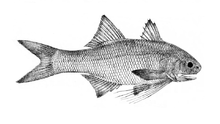Threadloss
| Threadloss | ||||||||||||
|---|---|---|---|---|---|---|---|---|---|---|---|---|

|
||||||||||||
| Systematics | ||||||||||||
|
||||||||||||
| Scientific name | ||||||||||||
| Polynemidae | ||||||||||||
| Rafinesque , 1815 |
The threadlocks (Polynemidae), also called fingerfish , are a family of the Carangaria . The approx. 40 species in eight genera live in tropical and subtropical regions around the world in shallow seas near the coast and in brackish water , always over sandy and muddy soft soils. Some species also migrate into rivers. Five species live exclusively in fresh water.
features
The animals get their name from their strange pectoral fins , the lower part of which consists of three to seven thread-like long rays (14–15 in Polynemus multifilis ). The threadlockers can use sensory organs to track down prey on these threads if they let them drag across the ground. The dorsal fins, a hard-nosed and a soft nosed, are clearly separated from each other by a gap. The pelvic fins are clearly located on the underside of the body, they are supported by a spine and five branched fin rays. The caudal fin is deeply forked. Threadlocks have 24 to 25 vertebrae, the mouth is below. They are eleven centimeters to two meters long.
Systematics
There are eight genera and over 40 species.
-
Eleutheronema
- Eleutheronema rhadinum ( Jordan & Evermann, 1902) .
- Eleutheronema tetradactylum (Shaw, 1804) .
- Eleutheronema tridactylum ( Bleeker , 1849) .
-
Filimanus
- Filimanus heptadactyla ( Cuvier , 1829) .
- Filimanus hexanema ( Cuvier , 1829) .
- Filimanus perplexa Feltes, 1991 .
- Filimanus sealei ( Jordan & Richardson , 1910) .
- Filimanus similis Feltes, 1991 .
- Filimanus xanthonema ( Valenciennes , 1831) .
-
Galeoides
- Galeoides decadactylus ( Bloch , 1795) .
-
Leptomelanosoma
- Leptomelanosoma indicum (Shaw, 1804) .
-
Parapolynemus
- Parapolynemus verekeri (Saville-Kent, 1889) .
-
Pentanemus
- Pentanemus quinquarius (Linnaeus, 1758) .
-
Polydactylus
- Polydactylus approximans (Lay & Bennett, 1839) .
- Polydactylus bifurcus Motomura, Kimura & Iwatsuki, 2001 .
- Polydactylus longipes Motomura, Okamoto & Iwatsuki, 2001 .
- Polydactylus macrochir ( Günther , 1867) .
- Polydactylus macrophthalmus ( Bleeker , 1858) .
- Polydactylus malagasyensis Motomura & Iwatsuki, 2001 .
- Polydactylus microstomus ( Bleeker , 1851) .
- Polydactylus mullani (Hora, 1926) .
- Polydactylus multiradiatus ( Günther , 1860) .
- Polydactylus nigripinnis Munro , 1964 .
- Polydactylus octonemus ( Girard , 1858) .
- Polydactylus oligodon (Günther, 1860) .
- Polydactylus opercularis Seale & Bean, 1907 .
- Polydactylus persicus Motomura & Iwatsuki, 2001 .
- Polydactylus plebeius (Broussonet, 1782) .
- Fingerfish ( Polydactylus quadrifilis ) ( Cuvier , 1829) .
- Polydactylus sexfilis ( Valenciennes , 1831) .
- Polydactylus sextarius ( Bloch & Schneider , 1801) .
- Polydactylus siamensis Motomura, Iwatsuki & Yoshino, 2001 .
- Polydactylus virginicus ( Linnaeus , 1758) .
-
Polynemus
- Polynemus aquilonaris Motomura, 2003 .
- Polynemus bidentatus Motomura & Tsukawaki, 2006 .
- Polynemus dubius Bleeker , 1854 .
- Polynemus hornadayi Myers, 1936 .
- Elegant paradise threadfish ( Polynemus multifilis ) Temminck & Schlegel , 1843 .
- Polynemus paradiseus Linnaeus, 1758 .
literature
- Joseph S. Nelson : Fishes of the World , John Wiley & Sons, 2006, ISBN 0-471-25031-7
- Roland J. McKay: Threadfins of the world (Family Polynemidae). An annotated and illustrated catalog of polynemid species known to date. FAO Species Catalog for Fishery Purposes. No. 3rd FAO Rome 2004. ( PDF )
Web links
- Fadenflosser on Fishbase.org (English)




